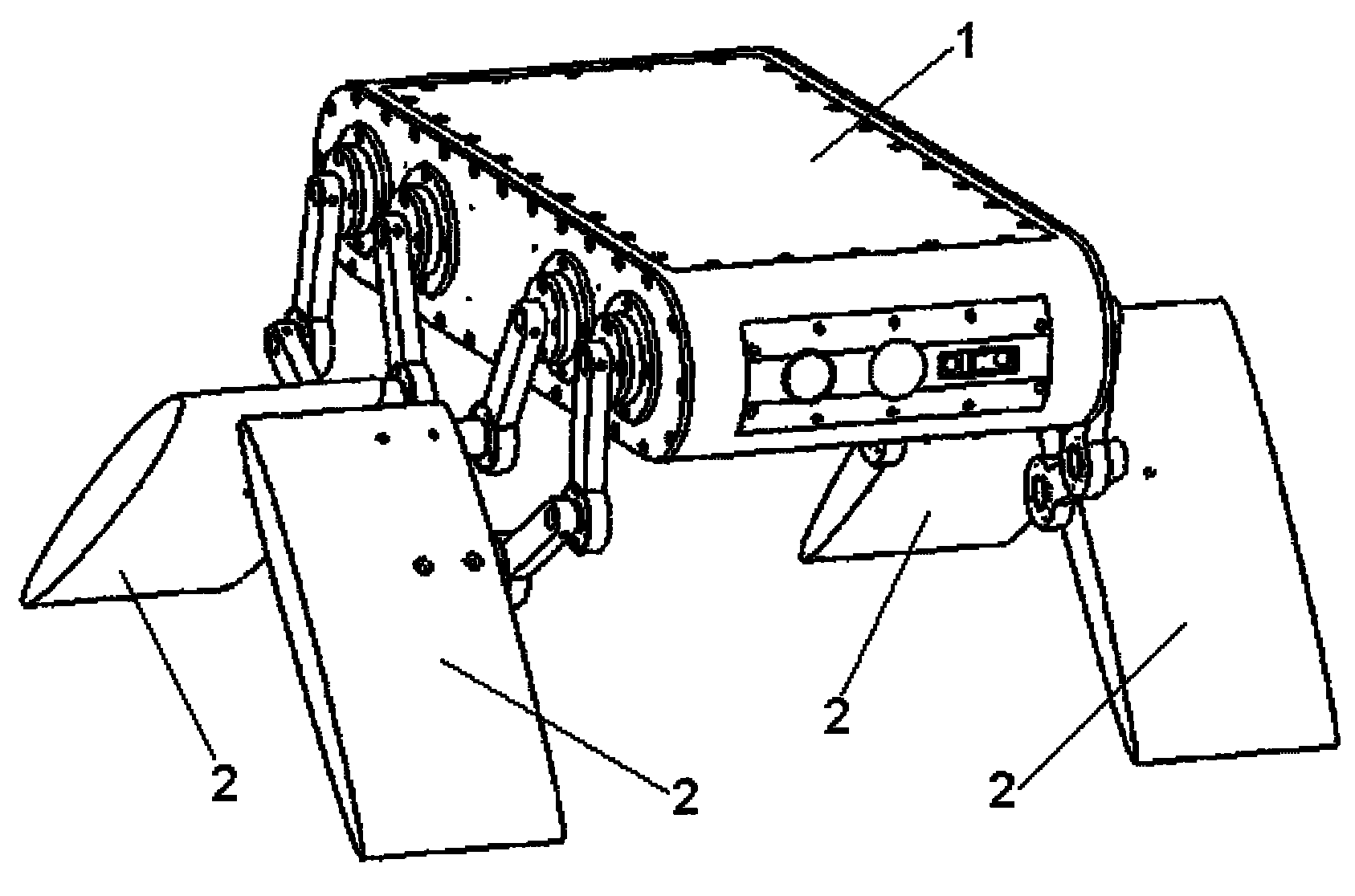Amphibious bionics robot
A bionic robot and amphibious technology, applied in the field of robotics, can solve the problems of redundant mechanism, complex system, poor stability, etc., and achieve the effects of improving adaptability, flexible movement, and good concealment.
Inactive Publication Date: 2010-11-10
PEKING UNIV
View PDF0 Cites 0 Cited by
- Summary
- Abstract
- Description
- Claims
- Application Information
AI Technical Summary
Problems solved by technology
Combining the traditional land and water propulsion methods, using two independent propulsion systems to realize water and land movement has disadvantages such as system complexity, mechanism redundancy, and poor stability. Therefore, a composite propulsion mechanism suitable for both land and water environments is designed. By changing Mechanism configuration and control methods to realize water and land movement are urgent problems to be solved in the design of amphibious robots
Method used
the structure of the environmentally friendly knitted fabric provided by the present invention; figure 2 Flow chart of the yarn wrapping machine for environmentally friendly knitted fabrics and storage devices; image 3 Is the parameter map of the yarn covering machine
View moreImage
Smart Image Click on the blue labels to locate them in the text.
Smart ImageViewing Examples
Examples
Experimental program
Comparison scheme
Effect test
Embodiment Construction
the structure of the environmentally friendly knitted fabric provided by the present invention; figure 2 Flow chart of the yarn wrapping machine for environmentally friendly knitted fabrics and storage devices; image 3 Is the parameter map of the yarn covering machine
Login to View More PUM
 Login to View More
Login to View More Abstract
The invention relates to an amphibious bionic robot which is characterized in that the amphibious bionic robot includes a sealed main cabin body and four propeller leg complex propelling mechanisms. A control device, a power supply device and a waterway environment detection sensor are arranged in the main cabin body; the four propeller leg complex propelling mechanisms are opposite in pairs and symmetrically arranged on two sides of the main cabin body; each propeller leg complex propelling mechanism includes two driving rods, a driven rod and a swing propeller; one end of each driving rod is respectively connected with the output ends of two motors; one driving rod is close to the middle part of the main cabin body, and the other end of the driving rod is connected with one end of the swing propeller through a rotating shaft; the other driving rod is close to the outer side of the main cabin body, the other end of the driving rod is connected with the driven rod through a rotating shaft; the driven rod is connected with the middle position of the swing propeller, the other end of the swing propeller is an execution tail end. The amphibious bionic robot has the advantages of goodadaptability to environment, stability and reliability, and flexible movement, thereby the amphibious bionic robot can complete various tasks for prospecting, working, etc. in marshes and offshore water, and play an important role in an offshore landing battle in the future.
Description
An amphibious bionic robot technical field The invention relates to a robot, in particular to an amphibious bionic robot based on a paddle-leg composite propulsion mechanism. Background technique According to the working environment, robots can be roughly divided into land, underwater and aerial robots. Due to the single working environment, the ability of robots to complete tasks in complex environments is greatly limited. In nature, after hundreds of millions of years of natural selection, animals have evolved excellent environmental adaptability. For example, most birds can fly in the air and walk on land. Among amphibians, turtles and crocodiles can not only It can swim in water and crawl on land. Inspired by amphibians, amphibious robots that can adapt to changing land terrains and complex water environments have aroused people's strong interest. Robots can work normally, show strong environmental adaptability, have the ability to complete complex tasks, and have gr...
Claims
the structure of the environmentally friendly knitted fabric provided by the present invention; figure 2 Flow chart of the yarn wrapping machine for environmentally friendly knitted fabrics and storage devices; image 3 Is the parameter map of the yarn covering machine
Login to View More Application Information
Patent Timeline
 Login to View More
Login to View More Patent Type & Authority Patents(China)
IPC IPC(8): B60F3/00
Inventor 胡永辉王龙周应波王琦赵惟楚天广谢广明
Owner PEKING UNIV
Who we serve
- R&D Engineer
- R&D Manager
- IP Professional
Why Patsnap Eureka
- Industry Leading Data Capabilities
- Powerful AI technology
- Patent DNA Extraction
Social media
Patsnap Eureka Blog
Learn More Browse by: Latest US Patents, China's latest patents, Technical Efficacy Thesaurus, Application Domain, Technology Topic, Popular Technical Reports.
© 2024 PatSnap. All rights reserved.Legal|Privacy policy|Modern Slavery Act Transparency Statement|Sitemap|About US| Contact US: help@patsnap.com










